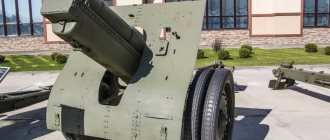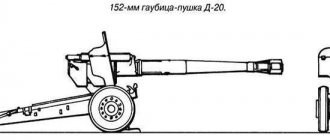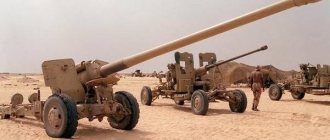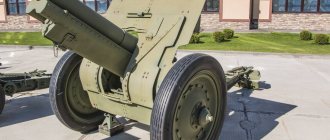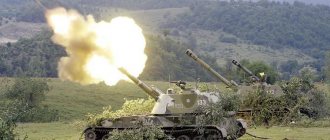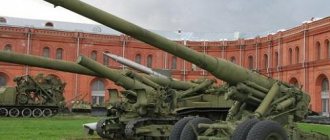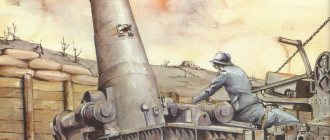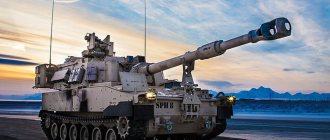Type Field gun Tank gun
| 122 mm gun model 1931/37 (A-19) | |
| M1931/37 in the museum on Sapun Mountain, Sevastopol | |
| Type | Field gun Tank gun |
| Place of origin | USSR |
| Production history | |
| Designer | Design Bureau of Plant No. 172, head F.F. Petrov. |
| Designed by | 1931–1938 |
| Manufacturer | Barricades Factory, Factory No. 172 |
| Produced | 1931–1946 |
| No. built | about 2450 |
| Characteristics | |
| Weight | Combat: 7,117 kg (15,690 lb) Travel: 7,907 kg (17,431 lb) |
| Length | 8.725 m (28 ft 8 in) |
| Barrel length | Bore: 5.485 m (17 ft 11.9 in) L/45 Overall: 5.65 m (18 ft 6 in) L/46.3 |
| Width | 2.345 m (7 ft 8 in) |
| Height | 2.27 m (7 ft 5 in) |
| Crew | 9 |
| Shell | 122 × 785 mm. R |
| Caliber | 122 mm (4.8 in) |
| Breech | broken screw |
| Recoil | hydropneumatic |
| Shipping | divided path |
| Height | -2° to 65° |
| Traverse | 58 ° |
| Rate of fire | 3-4 shots per minute |
| starting speed | 806 m/s (2,640 ft/s) |
| Maximum firing range | 20.4 km (12.67 mi) |
122 mm M1931/37 pistol body (A-19)
(Russian: 122 mm hull gun mod 1931/1937 (A-19)..) Was a Soviet field gun developed in the late 1930s, combining the barrel of a 122 mm M1931 gun (A-19) and the carriage of a 152 mm howitzer- M1937 (ML-20) guns. The gun was produced from 1939 to 1946. It participated in World War II (mainly with the corps and artillery of the Red Army RVGK) and remained in service for a long time after the end of the war. Vehicle-mounted versions of the gun were installed on the IS-2 and IS-3 tanks of the Joseph Stalin series of tanks and the ISU-122 self-propelled guns.
History of development[edit]
In 1936, the Red Army adopted the 122 mm M1931 gun, also known as the A-19. Unlike earlier artillery pieces used by the Red Army, it had a separate carriage with suspension and, as a result, improved mobility and controllability. However, the M1931 carriage had a number of disadvantages. The lifting mechanism was slow and unreliable; solid wheels limited mobility to some extent; Technological problems arose in the production of cars. [1]
Soon after M1931, the Red Army received another artillery piece - the 152-mm howitzer-gun M1937 (ML-20), developed at Plant No. 172 under the leadership of F. F. Petrov. This led to the modernization of the M1931, which was also carried out by Petrov's design bureau. The M1931 barrel was placed on a carriage from the ML-20. The improved gun was successfully tested in September–October 1938 and on April 29, 1939 it was put into service as the 122-mm M1931/37 hull gun
. Unusually, the new version, like the old one, received the designation A-19.
Characteristics and properties of ammunition
The gun had a separate case loading, it was equipped with four propellant charges (GAU index - Zh-471
) - full, No. 1, No. 2 and No. 3, placed in a metal sleeve 785 mm long. Charge No. 3 was the main beam, charge No. 2 the main beam and beam No. 3, charge No. 1 the main beam, beam No. 3 and one equilibrium beam, and the total charge the main beam, beam No. 3 and two equilibrium beams. Gunpowder 22/1, NF17/1 or N19/1, full charge weight - 6.82 kg. Both special cannon and howitzer shells were used for firing, but the latter, due to their lower strength, could not be fired with a full charge, and some howitzer shells (for example, OF-460A and OF-462A) were prohibited from being fired. The main shells used (often when firing at tanks) were high-explosive fragmentation shells. Armor-piercing shells were included mainly in the ammunition loads of self-propelled guns and cannons used in coastal defense; such shells were issued to field gun crews only when there was an immediate threat of attack on firing positions by enemy tanks. Concrete-piercing shells were used for firing at long-term firing points.
Production history [edit]
The M1931/37 was manufactured by the Barricades Factory
in Stalingrad (1939-41),
plant No. 172
(1941-46).
The number of M1931/37s produced is estimated at approximately 2,450, not including those mounted on vehicles. Production M1931/37s, pcs. [1]
| Year | 1939 | 1940 | 1941 | 1942 | 1943 | 1944 | 1945 | 1946 |
| Produced, pcs. | 256 (including M1931) | 469 | 442 | 385 | 414 | 160 | 245 | 206 |
Description[edit]
An M1931/37 (right) stands next to what appears to be its predecessor, the M1931, in the Artillery Museum in St. Petersburg.
Like the late production M1931 barrel, the M1931/37 barrel had a loose case design and consisted of a case, shroud, and screw-on breech. The breech was an intermittent screw type, similar in design to the M1910/37 152 mm howitzer. The recoil system consisted of a hydraulic recoil buffer and a hydropneumatic recuperator located inside the cradle under the barrel.
The gun had a split trail carriage, adapted from the 152 mm M1937 (ML-20) howitzer-gun. The carriage was equipped with spring suspension and metal wheels with pneumatic tires. The carriage also had a balancing mechanism. The shield gave the crew some protection from small arms fire and shell fragments.
The M1931/37 was transported as a single unit with the barrel retracted. Towing of a gun was allowed with the barrel in the normal position, but only for short distances and at a speed of no more than 4–5 km/h. Several types of artillery tractors were used: S-2 Stalinets-2, Comintern, and since 1943 Y-12.
Brief description of the design of the 122-mm howitzer model 1910/30.
The design of the gun consisted of:
- trunk;
- piston valve;
- carriage.
Howitzer barrel - fastened with a muzzle and casing, or a monoblock barrel. The bolt was a piston type, opened to the right. Opening - closing by turning the handle in one movement. The single-beam carriage consisted of:
- anti-recoil devices installed in the skids;
- cradles;
- machine;
- gun shield;
- guidance mechanisms
- sighting devices
During the production of the barrel, the muzzle and casing were fitted onto the pipe in a heated state; after cooling, they compressed it, becoming one piece. Operation of the 122-mm howitzer Model 1910 showed the low reliability of this mounting method; the muzzle slipped. During modernization, the muzzle mount was strengthened by connecting it to the barrel with a screw thread. In old barrels supplied for boring, the muzzle was fixed with stoppers.
However, even screw threads and stoppers did not always help in practice. The end of the pipe sometimes protruded a millimeter or more beyond the muzzle, but this did not affect shooting. Although in cases where the pipe moved forward as a single unit, it became difficult to open the valve. As a result, factory repairs were required. To correct this shortcoming of the howitzer mod. model 1910/30, a monoblock barrel was introduced.
The bolt of the 122-mm howitzer model 1910/30 consisted of:
- locking mechanism;
- ejection mechanism;
- safety;
- impact mechanism;
- easier loading;
- holding the sleeve.
The purpose of the locking mechanism is to seal off the powder gases. The ejection mechanism extracted the cartridge case from the chamber. The safety mechanism prevented the bolt from opening prematurely in the event of a prolonged shot. The impact mechanism made it possible to fire a shot. The case retention mechanism held the case while loading the gun at large horizontal elevation angles.
The recoil devices consisted of a hydraulic recoil brake and a hydropneumatic knurler installed in the slide. The sled of the 122-mm howitzer model 1910/30 was connected to the howitzer barrel and rolled back together.
The trough-shaped cradle was placed in the nests of the machine and was connected to the lifting mechanism. On top of the cradle there were skids that served as guides for the grips of the sled.
The lifting mechanism of the howitzer model 1910/30 is sectoral.
The gun mount served as the base of the swinging part. In the rear part of the machine, which rested on the ground, there was a summer folding and permanent coulter. There was a rule for rough aiming of the howitzer.
The combat axle had no suspension. Wheels were initially made of wood with iron tires. Since 1937, metal with rubber weights, similar to those wheels that were installed on the F-22. Since 1936, howitzers model 1910/30 were equipped with metal wheels with tires filled with spongy rubber. The wheels are similar in appearance to those installed on the M-30 howitzer.
The sights consisted of Hertz panoramas, as well as the sight itself. The sight is dependent, the direction of the optical axis of the panorama changed when the elevation angle changed. The sight was unified and differed from other guns in the mounting and cutting of the scales.
Towing of the 122-mm howitzer model 1910/30 was carried out either by six horses or by a mechanized tractor. Both cases involved the use of a front end. The howitzer's pivot foot was fitted onto the limber hook, which was equipped with a coupling device. The forward gear and charging box limbers are interchangeable. While the reverse gear of the charging box did not have a coupling device, instead there was a pin paw. The boxes of the charging boxes and limbers were sprung with strips of rubber. The boxes carried ammunition, and on top the crew and the necessary things for combat work and the campaign.
Organization and employment [edit]
Both variants, the M1931 and M1931/37, held equal prominence in Army organizations, were often used side-by-side with each other, and combat reports made no distinction between them; therefore, data in this section applies to the M1931 and M1931/37 together unless otherwise noted.
Red Army [edit]
M1931/37 at the Central Museum of the Armed Forces in Moscow.
The A-19 was originally intended for corps artillery. Together with the ML-20, it constituted the so-called “hull duplex”. In 1940–41 There were three types of corps artillery regiments:
- With two ML-20 battalions and one of the A-19 or 107 mm guns (24 ML-20 in total).
- With two ML-20 battalions and two A-19 or 107 mm guns (24 ML-20 in total).
- With three ML-20 battalions (36 ML-20 in total).
Soon after the start of the Great Patriotic War, the corps artillery was liquidated (as were the rifle corps themselves) and was re-commissioned only at the end of the war. These new artillery regiments received 122 mm guns along with other guns, mainly 107 mm guns and 152 mm howitzers, for a total of 16-20 per regiment. On June 1, 1944, the artillery of the Red Army corps had 387 A-19 (together with approximately 750 107 and 152 mm guns), and on May 1, 1945 - 289 A-19 (again, together with approximately 750 100 mm, 107 mm and 152 mm. pcs.). [2]
The gun was also used by artillery units of the reserve of the High Command (RVGK). In mid-1941, the RVGK cannon regiment had 48 A-19s; In the fall of 1941, these regiments were reorganized, with a new, smaller regiment consisting of 18 A-19s. Since 1942, gun brigades of 36 A-19s each were introduced. Such a brigade could be part of an artillery division - a huge formation numbering up to four A-19 or ML-20 brigades (that is, up to 144 pieces). [3]
The first combat use of the A-19 occurred at the Battle of Khalkhin Gol. [4] He also saw action in the Winter War. On March 1, 1940, there were 130 A-19 guns on the front line. Three pieces were lost.
By June 1941, the Red Army had, according to various sources, 1257 (1236 in the army and 21 in the navy) [5] or 1300 [6] A-19s. The weapon was used throughout the Great Patriotic War.
The A-19 was primarily used for indirect fire against enemy personnel, fortifications, and key objectives in the near rear. It was also equipped with armor-piercing shells for direct fire against armored targets. Although not an ideal anti-tank gun due to its large size, slow traverse, and relatively low rate of fire, in 1943 the A-19 was one of the few Soviet guns effective against new German tanks such as the Tiger and Elefant. [7] A tank gun variant, the D-25 was even capable of penetrating the upper glacis plate of a Tiger II at a range of 500-600 meters, although this required multiple rounds to be fired. [7]
A-19 No. 501 was the first gun to open fire on April 20, 1945, in the Battle of Berlin. [8]
Other operators[edit]
M1931/37 in the Poznań Citadel.
Polish wz. 1931/37/85.
At the initial stage of the Great Patriotic War, hundreds of A-19s fell into the hands of the Wehrmacht. Both variants were adopted - M1931 as 12.2 cm K.390 / 1 (r)
and M1931/37 as
12.2 cm K.390/2(r)
. In total, the Germans used 424 of these guns in field and coastal artillery and manufactured ammunition for them. [9]
In 1943, Germany sold 150 captured A-19s to Spain. This deal was part of the "Bär Programme", a program to complement and modernize the equipment of the Spanish armed forces using weapons supplied by Germany. Most of these A-19s were assigned to field artillery regiments of the Spanish Army Corps, each regiment receiving 12 to equip the group. The model was very popular in Spain, and 32 more copies were ordered by the army and produced - without documentation or licenses - at the Trubia arms factory. After the acquisition of more modern American artillery, Spanish A-19s were transferred to artillery regiments of territorial defense units. 173 Spanish A-19s were modernized in the 1970s, and the guns remained in service with the Spanish Army until the 1990s. [10]
In 1941, the Finnish army captured 25 of them and also put them into service. Both variants had the same designation 122 K / 31
.
Due to a shortage of heavy tractors, the gun was mainly used in coastal artillery. Four pieces were lost; the rest remained in service after the war. In the 1980s, some guns had their barrels replaced with 152 mm barrels from the ML-20; The resulting pieces were designated 152 H 37-31
.
In the late 1980s, 152 H 37-31 and the remaining 122 K/31 received new 152 mm L/32 barrels made by Vammas, becoming 152 H 88-31
.
The Kingdom of Romania captured in 1941 a number of 477 different types of 122 mm howitzers and guns including the M1931/37 and modern ones were used as divisional artillery for units rebuilt after the 1941 campaign. Some of the guns captured by the Romanians were modified and mounted on the initial prototypes of the Mareșal tank destroyer.
A-19s were used by Polish armed forces in the east in 1944-45 and remained in Polish service after the war. In 1952, the Polish Army had 63 units. In the 1980s, to increase mobility, Polish guns were equipped with wheels from the KrAZ-255B truck, resulting in the 122 mm wz. 1931/37/85
. [
quote needed
]
78 122 mm guns were delivered to Yugoslavia. [11] The People's Army of Vietnam also received A-19s and used them during the Vietnam War. [12]
Other recipients of the M1931/37 were Syria (at least 100, currently in storage) [13] and Egypt. [14] China also acquired a number of M1931/37s during the early stages of the Second Sino-Japanese War.
Organizational and staffing structure[edit]
122 mm howitzer mod. 1938 (M-30) in Poznan Citadel, Poland. Right side view, the gun clearly needs painting
The howitzer was a divisional weapon. According to the staff of the year, the rifle division had two artillery regiments - a light one (a division of 76-mm guns and two mixed divisions of two batteries of 122-mm howitzers and one battery of 76-mm cannons in each) and a howitzer (a division of 122-mm howitzers and a division of 152 -mm howitzers), a total of 28 pieces of 122-mm howitzers. In June 1940, another division of 122-mm howitzers was added to the howitzer regiment, making a total of 32 in the division. In July 1941, the howitzer regiment was expelled, the number of howitzers was reduced to 16. Soviet rifle divisions spent the entire war in this state. Since December 1942, the Guards Rifle Divisions had 3 divisions with 2 batteries of 76 mm cannons and one battery of 122 mm howitzers each, for a total of 12 howitzers. Since December 1944, these divisions had a howitzer artillery regiment (5 batteries), 20 122-mm howitzers. Since June 1945, rifle divisions were also transferred to this state.
In the mountain rifle divisions in 1939-1940 there was one division of 122 mm howitzers (3 batteries of 3 guns each), a total of 9 howitzers. Since 1941, a howitzer artillery regiment (2 divisions of 3 four-gun batteries each) has been introduced instead, and the number of howitzers becomes 24. Since the beginning of 1942, only one two-battery division remains, a total of 8 howitzers. Since 1944, howitzers have been excluded from the staff of mountain rifle divisions.
The motorized division had 2 mixed divisions (a battery of 76 mm cannons and 2 batteries of 122 mm howitzers each), with a total of 12 howitzers. The tank division had one division of 122 mm howitzers, 12 in total. Until August 1941, cavalry divisions had 2 batteries of 122 mm howitzers, a total of 8 guns. Since August 1941, divisional artillery was excluded from the cavalry divisions.
Until the end of 1941, 122 mm howitzers were in rifle brigades - one battery, 4 guns.
122-mm howitzers were also part of the howitzer artillery brigades of the Reserve of the Supreme High Command (RVGK) (72-84 howitzers).
Options [edit]
ISU-122 with A-19S cannon.
Tank IS-2, with D-25T.
- A-19S
- Slightly modified version of the A-19 for use in the ISU-122 self-propelled gun. - D-25
- In 1943, a tank gun based on the A-19 was developed for Joseph Stalin's new tank, in part because the existing 85 mm tank gun used in the first prototypes was considered insufficient;
The resulting prototype was the IS-122
.
However, safety concerns arose as the gun's muzzle brake exploded, nearly killing Marshal Kliment Voroshilov who was present. This fact caused some initial resistance to the adoption of the gun, but Stalin supported the decision to arm the tank named after him with a 122 mm cannon. The gun was redesigned to address the safety issue, and the resulting weapon was named the D-25
, in imitation of the earlier 85 mm D-5T gun.
D-25T
- tank version of the pistol (
T
stands for
Tank
, "tank" ADJ.). In the last days of November 1943, Fyodor Petrov's artillery brigade tested the 122 mm D-25 hull gun on the mounting of an 85 mm D-5T tank gun against a captured German Panther tank. The tests took place at the Kubinka test site (about 60 km west of Moscow). Firing from a distance of 1200 m [15], the projectile pierced the frontal part, pierced the engine block and pierced the rear shield. Following the overwhelming success of this test, the necessary changes were made over the following weeks, and on December 31, 1943, the model was accepted as the D-25T. Production began immediately to equip the IS-2 tank. - D-25S
- variant for use in late production ISU-122 self-propelled guns (
S
for
samokhodnaya
, 'self-propelled').
The ISU-122 variant armed with this gun was designated ISU-122S
.
- Finnish modernization, which involves increasing the caliber to 152 mm.
1931/37/85 - Polish modernization.
About modifications
The D-30 howitzer served as the basis for the creation of the following artillery options:
D-30A. The first modification was produced in 1978. The howitzer has a new two-chamber muzzle brake, the shield is equipped with brake lights and side lights.
- DA18M-1. The howitzer design has a special rammer.
- D-30J. It is a Yugoslav modification.
- Saddam. This is the name given to the D-30, produced by the Iraqi arms industry.
- Toure-96. The D-30 modification is produced in China.
- Khalifa. Sudanese model of an artillery gun. The self-propelled artillery mount is mounted on a KAMAZ-43118 chassis. Equipped with a D-30 cannon.
- Semser. The work of Israeli gunsmiths. Produced for the Kazakh army. The chassis is represented by the KAMAZ-63502 chassis. Artillery fire is fired from the barrel of a D-30 howitzer.
In addition, on the basis of the howitzer, Russian weapons designers designed the Gvozdika self-propelled artillery mount. At the moment, various modifications of the D-30 are used by the armies of over 50 countries.
Ammunition[edit]
The gun fired separately loaded, cased ammunition, with one of four possible propellant charges - full, no.
1, issue 2 and no. 3 (smallest). In addition to 122 mm gun shells, the A-19 could fire 122 mm howitzer shells; however, due to the lower durability of these shells, they could not be used with a full charge. Available ammunition [1] [16]
| Type | Model | Projectile weight, kg | OH mass, kg | Initial bullet speed, m/s | Range, m |
| Armor-piercing shells | |||||
| ARNE | BR-471 | 25,0 | 0,156 | 800 | 4 000 |
| ARNEVS (since early 1945) | BR-471B | 25,0 | 800 | 4 000 | |
| High explosive and fragmentation shells | |||||
| HE-Fragmentation, gun | OF-471H | 25,0 | 3.8 | 800 | 19 800 |
| HE-Fragmentation, gun | OF-471 | 25,0 | 3,6 | 800 | 19 800 |
| High explosive howitzer | OF-462 | 21,7 | 3,67 | 800 | 16 600 |
| HE-Fragmentation, gun | OF-471V | ||||
| HE-Fragmentation, gun | OF-472 | ||||
| Anti-concrete shells | |||||
| Anti-concrete, gun | G-471 | 25,0 | 2.2 | 800 | 20 400 |
| Chemical shells | |||||
| Frag/chemical pistol | OH-471 | 25,0 | 800 | 19 800 | |
| Chemical, howitzer | H-462 | 21,8 | 705 (charge No. 2) | 19 800 | |
Armor penetration [1]
| ARNEVS projectile BR-471B | ||
| Distance, m | Meeting angle 60°, mm | Meeting angle 90°, mm |
| 500 | 125 | 155 |
| 1,000 | 120 | 145 |
| 1,500 | 110 | 135 |
| 2 000 | 100 | 125 |
| 3 000 | 85 | 105 |
| APHE projectile BR-471 | ||
| Distance, m | Meeting angle 60°, mm | Meeting angle 90°, mm |
| 500 | 120 | 150 |
| 1,000 | 105 | 130 |
| 1,500 | 95 | 115 |
| 2 000 | 80 | 100 |
| 3 000 | 65 | 75 |
| Different countries/periods used different methods for measuring armor penetration. Therefore, direct comparison is often not possible. | ||
Tactical and technical characteristics of the D-30A howitzer
– Adopted into service: 1963- Manufacturer: Plant No. 9, PMZ (2A18 for SAO 2S1)
Calculation: 6 people
Projectile speed D-30A
– Initial speed of a high-explosive fragmentation projectile (full charge): 690 m/s- Initial speed of a high-explosive fragmentation projectile (reduced variable charge): 270-565 m/s- Initial speed of a cumulative projectile: 740 m/s
– Maximum pressure of powder gases: 250 MPa – Weight of high-explosive fragmentation projectile: 21.76 kg – Weight of cumulative projectile: 14 kg – Weight of charge (full): 4 kg
Firing range of D-30A
– Longest firing range: 15.4 km
Overall dimensions D-30A
– Barrel length with muzzle brake (without pivot beam): 4.66 m (38klb) - Barrel length without muzzle brake: 4.3 m (35klb) - Length of the rifled part: 3.4 m - Howitzer length in stowed position: 5 .4 m - Width of the howitzer in the stowed position: 2.2 m - Height of the howitzer in the stowed position (excluding lights): 1.8 m - Height of the line of fire: 0.9 m - Length of the howitzer in the firing position at an elevation angle of 0° : 7.8 m - Distance between the support points of the carriage in the firing position: 5.6 m - Ground clearance (minimum): 0.325 m
– Number of rifling: 36- Highest elevation angle: 70°- Lowest declination angle: −7°- Horizontal firing at a barrel elevation angle from −5° to 18°: 360°- Horizontal firing at an elevation angle from +18° to 70° and when the barrel is positioned between the movable frames: 66° - Horizontal fire at an elevation angle from +18° to 70° and when the barrel is positioned between the fixed and movable frames: ±29° - The amount of Steol M liquid in the brake of the recoil parts: 10, 3 l - Amount of Steol M liquid in the knurl: 9.7 l - Amount of Steol M liquid in the balancing mechanism: 0.45 l - Initial pressure in the knurl: 4.6 MPa - Normal rollback length: 0.74-0.93 m - Pressure in the balancing mechanism: 6MPa
Weight D-30A
– Howitzer in combat position: 3200 kg.- Howitzer in stowed position: 3290 kg.- Barrel: 1.05 t- Bolt: 30 kg- Pumping part: 1.5 t- Recoiling part: 1.23 t- Cradle: 210 kg - Brake of sliding parts, assembled: 75 kg - Upper machine: 212 kg - Lower machine with a fixed frame: 318 kg - Beds (two): 310 kg - Knurling assembly, assembled: 73 kg - Wheels with hub: 148 kg - Ski installation: 270 kg
Rate of fire D-30A
– Howitzer rate of fire: 6-8 rounds/min; Transfer time from traveling to combat position: 1.5-2.5 min.
– Highest transport speed: 80 km/h
Surviving figures[edit]
M1931/37 at the US Army Ordnance Museum.
M1931/37 can be seen among other places:
- In the Central Museum of the Armed Forces, Moscow, Russia.
- In the Museum of Artillery and Engineering Troops, St. Petersburg, Russia.
- In the Museum of the Heroic Defense and Liberation of Sevastopol on Sapun Mountain, Sevastopol, Ukraine.
- In the Poznan Citadel, Poland.
- At the US Army Ordnance Museum in Aberdeen, Maryland, USA.
- On the grounds of the Fort Sill Ordnance Museum in Lawton, Oklahoma, United States.
- In the Military Museum, Dej, Romania.
- In the El Goloso Armor Museum, Madrid.
- In the Military History Museum of Cartagena (Spain)
- In the video you can see the M1931/37 used by the Syrian army against IS and Al-Nursa in September 2016.[17]
Operators
- Algeria - 100 as of 2022
- Guinea - 12 guns as of 2016
- Egypt - 36 as of 2022
- DPRK - a certain number in the ground forces and coastal defense forces as of 2022
- Cuba - some in coastal defense artillery as of 2022
Former operators
- Bulgaria - 25 guns, as of 2007
- Spain - 150 guns, the last ones removed from service in 1991.
- Yemen - 248 guns, as of 2007
- Poland - more than 60 guns, removed from service
- Romania - 41 guns, as of 2007
- Syria - up to 100 guns, some may remain in storage, as of 2007
- Germany - up to 400 guns
- Finland - up to 25 guns, removed from service
- Yugoslavia - 78 guns, removed from service
Notes[edit]
- ^ a b c d Shirokorad A.B. — Encyclopedia of Soviet Artillery
. - ↑
Military History Magazine, No. 5, 2005. - Military History Magazine, No. 2, 2006.
- Kolomiets M. - Battle on the Khalkhin Gol River
. - ↑
Statistical collection No. 1 - Red Army June 22, 1941 - Ivanov A. - Artillery of the USSR in World War II.
- ^ ab "Was the Tiger a King?" . Russian battlefield
. Archived from the original on October 24, 2014. Retrieved October 24, 2014. - "Source" . Bastion-karpenko.ru. Archived from the original on December 29, 2015. Retrieved August 24, 2015.
- Shirokorad A.B. - God of War of the Third Reich.
- Molina Franco (2014), pp. 254-262
- "Armament of the armies of socialist states in the West and East". Soldat.ru. Archived from the original on June 10, 2009. Retrieved August 24, 2015.
- Schuster, Carl Otis; Coffey, David (May 2011). "Vietnam, Democratic Republic, Army." In Tucker, Spencer S. (ed.). Encyclopedia of the Vietnam War: Political, Social and Military History
(2nd ed.). item 1251. ISBN 978-1-85109-960-3. - "GOAL & p≈p▓p ·" . Commi.narod.ru. Archived from the original on October 25, 2010. Retrieved August 24, 2015.
- "Egyptian Ground Forces". waronline.org. Archived from the original on January 27, 2011. Retrieved August 24, 2015.
- "World of Tanks: Today in History: D-25T Tests". Wargaming RU. Archived from the original on November 9, 2014. Retrieved November 13, 2014.
- Ballistic tables for M1931 and M1931/37 hull guns.
- "Archival copy". Archived from the original on October 10, 2016. Retrieved 9 October 2016.CS1 maint: archived copy as title (link)
Project evaluation
For its time, the 122-mm cannon of the 1931/37 model was a completely modern, structurally perfect weapon, successfully combining high firepower, mobility, manufacturability and unpretentiousness in operation. By modifying the 122-mm gun of the 1931 model, Soviet designers were able to get rid of most of its shortcomings associated with the design of the carriage; in addition, the unification of the A-19 and ML-20 carriages significantly reduced the cost of production and operation of both artillery systems. The success of the gun's design is confirmed by the long service of this artillery system in various countries of the world, in some of which it is in service to this day.
Comparing the gun with other artillery systems is difficult due to the lack of analogues. Numerous 105 mm cannons, such as the German 10.5 cm K.18, were lighter and had a similar or slightly longer firing range, but the mass and lethality, both fragmentation and high explosive, of their 15 kg projectile were no match for What's the comparison with the 25-kilogram A-19 projectile? Powerful 150-mm cannons like the German 15 cm K.18, with a heavier projectile and a significantly longer firing range, were much heavier and, accordingly, were much inferior to the A-19 in cost and mobility. Comparison with 128-mm German guns is incorrect - these guns appeared at the very end of the war, had powerful ballistics and heavy weight (8.3-12.2 tons). Old guns from the First World War with a single-beam carriage, such as the Polish 120 mm wz.78/09/31 or the British 127 mm 60 pounder, were significantly lighter, but had a significantly shorter firing range (11-12 km). Only the Belgian 120 mm gun, the British 114 mm BL 4.5 inch and the American 4.5 inch Gun M1 can be considered complete analogues of the A-19. The Belgian gun was significantly lighter than the 122-mm cannon of the 1931 model (5.4 tons in firing position), but had a slightly lighter projectile (21.9 kg) and a shorter firing range (17.6 km). The British gun was also much lighter (5.7 tons in firing position) and had very similar characteristics with projectile mass (24.95 kg) and firing range (18.8 km). It is worth noting that despite the fact that the British gun appeared approximately simultaneously with the Soviet one (serial production since 1937), its production at first was not widespread (by 1940, only 72 guns were produced). The American gun, which was a superposition of the barrel group of a British cannon on the carriage of a 155-mm M1 howitzer, with a projectile mass and firing range close to the A-19, was also lighter (5.6 tons), but this gun was developed significantly later than the A-19. 19, and its release was not widespread.
Sources [edit]
- Shirokorad A.B. - Encyclopedia of Soviet Artillery
- Mn. Harvest, 2000 (Shirokorad A. B. Encyclopedia of domestic artillery. - Mn.: Harvest, 2000., ISBN 985-433-703-0) - Shirokorad A.B. - God of War of the Third Reich
- M. AST, 2002 (Shirokorad A. B. - God of War of the Third Reich. - M., LLC Publishing House AST, 2002., ISBN 5-17-015302-3) - Ivanov A. - Artillery of the USSR in the Second World War
- St. Petersburg Neva, 2003 (Ivanov A. -
Artillery of the USSR in the Second World War
. - St. Petersburg, Neva Publishing House, 2003., ISBN 5-7654-2731-6) - Kolomiets M. - The Battle of the Khalkhin Gol River
- Front-line Illustration magazine, No. 1. 2, 2002 (M. Kolomiets. - Battles near the Khalkhin-Gol River. - Front-line Illustration magazine, No. 2, 2002) - Military-historical magazine. 5, 2005 and no. 2, 2006.
- Statistical collection No. 1 - Red Army June 22, 1941
- Ballistic tables for hull guns M1931 and M1931/37 - Military Publishing House NKO, 1944.
- Shunkov V.N. — Weapons of the Red Army
, Mn.
Harvest, 1999 (Shunkov V.N. - Weapons of the Red Army.
- Mn.: Harvest, 1999.) ISBN 985-433-469-4 - Zaloga, Stephen (1994), IS-2 Heavy Tank 1944-73
, New Vanguard, Osprey, ISBN 1-85532-396-6 - Molina Franco, Lucas (2014). La ayuda militar alemana a España 1939-1945 (Dissertation) (in Spanish). Universidad de Valladolid. Facultad de Filosofía y Letras.
- Fourth Ally of the Third Axis: Romanian Armed Forces in the European War 1941-1945, 1 May 1995, p. 142, p. 224 ISBN 1854092677
